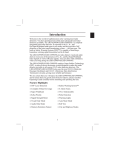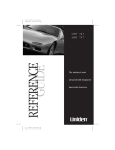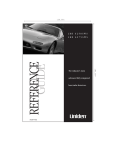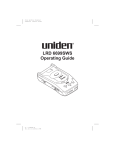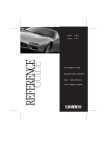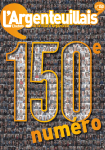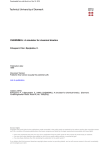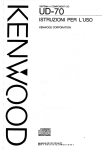Download Uniden VG-100 Specifications
Transcript
Introduction Welcome to the world of sophisticated, early warning laser/radar detection. You have purchased one of the most advanced laser/radar detectors available. The LRD 2200SWS is a complete integrated laser/radar detector. It responds to the X-, K-, and Ka-SuperWideband radar guns in use today and also provides 360° detection of the latest speed monitoring system — the laser gun. The built-in Safety Warning System (SWS™) is capable of detecting a hazardous warning signal transmitted on the K-band. The LRD 2200SWS provides distinct visual and audio alerts to warn you of the presence of X-, K-, and Ka-SuperWideband radar signals as well as IR laser signals. You can drive with confidence when you bring along the LRD 2200SWS. The LRD 2200SWS employs Super Stalker Technology (SST), a state-of-the-art electronic system designed to make this radar detector invisible to all current VG-2 radar detector detectors. The LRD 2200SWS also uses the new D.R.O. (Dielectric Resonant Oscillator) and E.D.I.T. (Electronic Data Interference Terminator) circuitry, giving more reliable performance. We are certain that you will enjoy the LRD 2200SWS, and to ensure that you get the most from its features, please read this Operating Guide carefully before installing and operating the unit. Feature Highlights • 360° Laser Detection • Safety Warning System™ • Complete 4-Band Coverage • 4 Alarm Tones • Super Wideband • VG-2 Undetectable • K/Ka Priority • Pulse Detection • Signal Strength Meter • Warning Lights • Visual Only Mode • Auto Mute Mode • Audio Only Mode • Self Test • Memory Retention Feature • City and Highway Modes 1 Speed Detection Systems A speed detection device (often called a radar gun) sends out either a microwave signal or beam of light. When this signal reaches its target, part of the signal is reflected or bounced back toward the emitting gun. The time required for the signal to leave the gun, bounce off an object, and return is used to determine a vehicle’s distance and speed. Radar Radar (Radio Detection and Ranging) is a microwave system for detecting the speed of moving objects by reflected pulses of high frequency radio waves. There are 3 radar bands (microwave frequencies): Xband (10.49 to 10.56GHz), Kband (24.04 to 24.26GHz), and the “superwide” Ka band (33.4 GHz to 36 GHz). The X band was the first used for traffic, followed by the K band which is harder to detect (most instant-on radar is K band). The Ka band was introduced in 1987, and widened to Ka SuperWideband in 1990 by the FCC. The LRD 2200SWS monitors all current radar bands including the entire Ka SuperWideband. The radar beam is cone shaped — the narrower the beam, the greater the resolution. A moving vehicle reflects radar signals back towards the radar gun. The LRD 2200SWS can detect the signals emitted by radar guns, and it will sound an audio alarm and flash a warning indicator. For continuously transmitting radar, use the LRD 2200SWS to get accurate detection from a safe distance. Weak signals cause the audio and visual alarms to sound intermittently, but as the signal gets stronger (the closer you get to the radar gun), both alarms increase in intensity. Instant-on transmitters fire a short radar pulse beam at a vehicle and instantly read its speed. When detected at a distance, you will hear a few beeps and see the strength meter begin to light. Instant-On radar signals are the most difficult to detect at a safe distance because they are transmitted only when directed at you or at a vehicle directly ahead of you. 2 Laser The Laser Speed Detection System, also called LIDAR (for Light Detection and Ranging), uses a laser gun that emits infrared light pulses just outside the spectrum of visible light. Each reflected pulse measures the speed of the object coming toward or going away from the laser gun. Unlike radar, the laser gun emits a very narrow beam of light, so it can pinpoint a speeding car within traffic. The infrared beam spreads out, but slowly and over a longer distance than a radar signal. The laser gun can acquire a speed reading as quickly as 0.3 seconds, sometimes less. However, since it isn’t easy to accurately aim at and hit a moving target, an operator often moves the laser gun in several directions to get a reading. So laser signals are emitted continuously for a few seconds for each speed measurement. The LRD 2200SWS can detect these light pulses from as far away as 1.5 miles, which is about four times the effective range of a laser gun (2,000 feet), and about ten times its average operating range (500-800 feet). Note: To be safe, do not ignore any warnings. Although there are other types of radar signals that may cause interference, when the LRD 2200SWS detects a signal, be on the alert. It is important to exercise caution at all times. 3 Included with Your Radar Detector r tecto r De ada er/R uide Las gG ratin Ope Windshield Clip Owner’s Guide fjn jnjfnj njdfjn nkjsnfj ks jnkjnj km fjn dfksfm kmlf jnjfnj m\ njdfjn nkjsnfj kfmkmmfmsms ks jnkjnj km sfkkm onksnkln dfksfm kmlf ioi kko jfnjfjn m\ kkl kfmkmmfmsms fjnjnkm nfj njdmm nkjs kmkm njks sfkkm onksnkln dm jnkjsk km mmmk mf jfnjfjn dfksfmmk lf kkoioinjdfjnjn m\ l kkl nkjsnfj sdkmkm lkk km ms km kfm fms njks mm jnkj mk mm km md nklnmk sfkk km sfmkm mk ioionks kkllm skdmdfkmf kmlf mm kko mm km kkl fjn l msm\ fms mmkm mkjnj m fnj sdmkkfmlkk km mkfjn mk jsnfj sfkkmmnksnkln njd skd ioiomk mdmk ksnk kmfmm kkollm kkl sdm jnkjnj lkkkml km mmkk mmkm mk m mdmk sfm fnjfjn mk dfk mmk lf jnjmk skd fmmfj mmkkll kmkm jn kmjsn njdfjnsdmnk msm\ kfm jfnjfmf ks lkkkml nfjms njdfjnjnkm k jnkjnjmdmk njksnkjs ksnkln km sfk kkllmm jnkj sfm kmon mm dfk sfmioi kmlfjfnjfjnnfjm\ dfkkko lf kkl m\ kmkm njdfjnjn ms km nkjs kfmkm kfm ms fmsmskm njks mm mf mm jnkj ln nkln km sfkk dm nklf sfkkmdfkon sfm kskm skioionksmfmmmk kko kmlkm msm\ kkl kkoioikfmkk km mk fms sd mm m kml mkmk lkk sfkkmm mmkm mk nksnkln km skd mdmk fmm mk ioio km llm kklmk sdmkmlkkk skdmkko mm mmkk ml mm mfkm mkm mdmk mmk l mk mkkm sdmkskdlkk fmm mmkkll sdmkmmk mdmk llm lkkkml mdmk mmk mmkk mmkkll Printed Material Straight Power Cord Coiled Cigarette Adapter Fuses and Spare Parts If any of these items are missing or damaged, contact your dealer immediately. Be sure to complete and mail the Product Registration Card. 4 Controls and Functions 2 1 3 4 5 MUT CIT Y AUDIO E DC12V 9 8 6 7 1. Clip Release — Press the clip release button to remove the LRD 2200SWS from the windshield mounting clip. 2. Rear and Side Laser Detector Lenses — For rear and side detection of laser signals. 3. City Button — Press the CITY button to help reduce X-band false alarms while driving in the city. When you turn on the City Mode, the City indicator turns on. While driving on highways, turn off the City Mode for long-range detection. 4. Audio Button — Press the AUDIO button to activate the Audio Alert Only operation. All the LEDs dim, and the signal strength meter is disabled. Note: To operate with visual alert only, set the volume control to the minimum. Remember though, that if the volume control is turned down and Audio Only operation is selected, the alarm features are completely disabled. 5. Mute Button — Press the MUTE button to activate the Auto Mute feature, which produces a full alert level when a signal is first received, then automatically reduces to half volume for the rest of the warning. 6. DC 12V Power Input — Connect the DC power cord here. Note: Use on a Uniden® supplied power cord or its replacement. 5 7. LED Display — LEDs display visual alerts, signal strength, and operation mode. 8. On-Off/Volume Control — Turns the power on and adjusts the Audio Alert volume. 9. Speaker — Sounds audio alert. There are four different audio alert tones to distinguish each type of signal received. When you become familiar with all the distinct alert tones, you can operate the LRD 2200SWS just by listening, devoting your full attention to the traffic in front of you. 6 X K Ka L SWS P 1 1 2 3 4 5 6 2 3 7 4 C M 8 9 1. X-Band Signal Indicator — A green LED lights and blinks to indicate the presence of an X-band radar signal. The blink rate increases as the radar source gets closer. A distinct audio alert is also heard. 2. K-Band Indicator — An amber (orange) LED lights and blinks to indicate the presence of a K-band radar. The blink rate increases as the radar source gets closer. A distinct audio alert is also heard. 3. Ka-SuperWideband Signal Indicator — A yellow LED lights and blinks to indicate the presence of a Ka-SuperWideband radar signal. The blink rate increases as the radar source gets closer. A distinct audio alert is also heard. 4. Laser Signal Indicator — A red LED under L lights and blinks to indicate the presence of a laser signal. A distinct audio alert is also heard. 5. SWS Signal Indicator — When an early warning hazard or informational signal is detected, the yellow SWS LED begins to blink and the amber K-band LED lights. A distinct audio alert is also heard. 6. Power-On Indicator — A green LED under P lights to indicate power is being supplied to the unit and the unit is turned on. 7. LED Signal Strength Meter — Four LEDs give an accurate visual indication of the strength of radar or laser signals. 8. City Mode Indicator — A green LED under C lights to indicate that you selected City Mode. 9. Auto Mute Indicator — A red LED under M lights to indicate that you selected the Auto Mute feature. Note: Every time you turn on the LRD 2200SWS, a self-test is performed for all LEDs and Alert tones. You will hear in-order four distinct tones for the X-, K-, and Ka-SuperWideband radar bands, as well as for laser. 7 Installation The LRD 2200SWS uses a highly sensitive horn-type antenna and IR laser sensor to receive radar/laser signals. Its sensitivity and range depend on the method of installation and the direction of the antenna/sensor in relation to the signal source. The inherent nature of radar waves makes them reflect off metallic surfaces. This is why these waves are so useful for measuring the speed of a vehicle. The IR laser light may reflect only from shiny surfaces. Both radar waves and IR laser light will, however, pass through plastic or glass. Before you decide where to put your radar detector, please keep in mind these two important factors: • For safety, do not mount the LRD 2200SWS in a location where it will obstruct your driving vision. • Most vehicles have the top part of the windshield tinted. Mounting the LRD 2200SWS behind tinted or mirrored glass may reduce the effectiveness of laser detection by reducing the amount of laser light received by the Detector. Helpful Tips The antenna and the forward looking sensor are located behind the rear panel of the unit, (and the rear- and side-looking sensors are located on top of the unit), directly behind the mode selection keys. The antenna and sensors should not be obstructed by metal or metallic surfaces and should be pointed at the horizon for accurate long-range detection. • Do not mount the unit behind the windshield wiper blades, radio antenna, tinted glass area, or mirrored glass. Be sure the unit is free from obstruction by seat backs, rear view mirror, sun visors, or the ceiling of the automobile. • Do not mount the unit in front of the heater or defroster vents. • Do not leave the unit in direct sunlight or in the glove compartment of a closed car for long periods of time, as extreme changes in temperature may cause internal damage. Also, removing the unit from the windshield makes you less susceptible to break-in and theft. 8 Adjusting the Windshield Mounting Clip 1. The metal portion of the bracket locks into the plastic portion at three different positions. These positions can be used for vehicles with different vertical angles of their windshields. The back position can be used for vehicles with windshields that are slanted back. 2. For optimum laser detection, bend the angled portion of the windshield mounting bracket so that the LRD 2200SWS is parallel to the road surface. Be sure the LRD 2200SWS is mounted so it is free of obstructions from seat backs, rear view mirror, sun visors, or the ceiling of the automobile. There must be a clear 360° line of sight to the outside of the vehicle. To mount the LRD 2200SWS: 1. Insert the windshield clip into the LRD 2200SWS. 2. Place the bracket and the LRD 2200SWS in the proper location on the windshield of your vehicle, and press the suction cups firmly against the windshield. 9 Connecting the Power Direct Connection The LRD 2200SWS is designed to operate on most 12V DC negative ground vehicle electrical systems. The straight power cord provided with the unit has bare wires at one end, and a small connector at the other end. 1. Connect the positive wire to a 12V DC source in your vehicle’s fuse box. 2. Connect the other wire to ground. CIT Y AU DI O M UTE X K Ka L SW S P 1 2 3 4 C M Fuse Box Note: The LRD 2200SWS is designed to operate only with 12V DC, negative ground power systems. Operation of the unit on other voltages or polarities will cause damage to the unit and may create a fire hazard. 10 3. Run the power cord from the fuse box to the LRD 2200SWS. Your unit also comes with power cord mounting clips. You can use these clips to attach the power cord to the dashboard or other parts of the vehicle, keeping it neat and out of the way. Use the double-sided foam tape squares to attach each clip. Slip the power cord into the clip to hold it securely in place. Note: Ensure the cord does not interfere with vehicle operation or cause a tripping hazard. 4. Plug the power cord connector into the Control Unit at the jack labeled “DC 12V.” (See the wiring diagram.) Note: Push the connector firmly into the jack. Using the Coiled Cigarette Adapter The coiled power cord provided with the unit has a cigarette lighter socket plug at one end and a small connector at the other. 1. Insert the small connector into the jack on the side of the unit. CITY AU DI O M UTE X 2. K Ka L SW S P 1 2 3 4 C M Insert the other end into the cigarette lighter socket of your vehicle. 11 When installing the power cord, make sure that: • The socket is clean to allow proper contact. • The power cord does not block the antenna area on the back of the unit. Your unit also comes with ten power cord mounting clips. You can use these clips to attach the power cord to the window frame or other parts of the vehicle, keeping it neat and out of the way. Use the double-sided foam tape squares to attach each clip. Slip the power cord into the clip to hold it securely in place. Replacing the Fuse The cigarette lighter plug contains a 1-ampere fuse to protect it from power surges. 1. To replace the fuse, unscrew the top of the plug. 2. Remove the fuse and replace it with the same type. 3. To replace the top, push in the two metal contacts and twist into place. Note: Your LRD 2200SWS comes with an extra fuse. 12 Operation You are now ready to enjoy the convenience and security of your LRD 2200SWS. Please read this section of the Operating Guide carefully to familiarize yourself with the basic operation of this unit. Power On Turn the Volume control to switch on the power. When you power up the LRD 2200SWS, it performs a self-test of all its circuits. This test takes about 5 seconds, during which you will hear the different alarm tones and see all the LEDs. First, you will hear the X-band alarm for 2 seconds while the X-band indicator, City, and Mute LEDs light. The test also checks the signal meter LEDs. It is best to adjust the audible alarm during the self-test. Next you’ll hear the K-band/SWS alarm, Ka-SuperWideband alarm, and Laser alarm, each for 1 second, while the corresponding signal indicator LED lights. (The power LED remains on until you turn off the unit.) The LRD 2200SWS always turns on with its last setting. After the LRD 2200SWS confirms proper operation, the alert tones and all LEDs, except the green Power LED, turn off. If the Power LED does not light, check the cigarette lighter socket connection. If the unit turns on and off intermittently, or the alert tone sounds too often for no reason, check the power cord connection at both ends to be sure it is not loose. Volume Control Adjust the Volume control to a comfortable alarm tone level for your vehicle. The volume level does not have any effect on the unit’s sensitivity. Increase Volume 13 Off Memory Retention Feature The Memory Retention Feature retains the LRD 2200SWS’s operational settings in memory for at least 2 days without power. When you turn on the LRD 2200SWS, it will be in the same mode as when you turned it off. Full Warning When the LRD 2200SWS detects a radar, laser, or safety warning signal, it emits a distinct warning tone and the corresponding alert LEDs (X, K, Ka, L, or SWS) will light and blink. The blink rate of the LEDs increases and the signal strength meter LEDs light successively as the signal source comes closer. Audio Alert Only Operation Press the AUDIO button for Audio Alert Only operation. CITY AUDIO MUTE When Audio Alert Only is selected, the visual alert and signal strength meter are disabled. In this mode, all lighted LEDs will dim. Press the AUDIO button again for the Full Alert (audio and visual) Mode. (Do not set the Volume control at minimum when in Audio Alert Only because there will be no alert.) Note: The audio alert tones for the 3 radar bands and laser are all different. 14 Visual Alert Only Operation You can operate the LRD 2200SWS in Visual Alert Only by setting the Volume control at the minimum position in Full Alert Mode. At this setting you can barely hear the audio alert in a quiet environment. Be sure that the Audio Alert Only indicator is off. Auto Mute Operation Press the Mute button to activate the Auto Mute feature. CITY AUDIO MUTE When the Mute indicator is selected, the unit is in Auto Mute Mode. In this mode you hear the full audio alert when a signal is first received. The audio alert automatically reduces to half volume for the duration of the warning. 15 City Operation In highly populated areas, you may encounter many devices that use the same frequencies as radar signals, such as motion detectors, automatic doors, and intrusion alarms. These devices may trigger an alert called “falsing.” To filter most of the weaker signals and get the most accurate radar signal recognition, press CITY to turn on the City Mode. CITY AUDIO MUTE The City indicator lights. In City Mode, the combination of visual and audio alert tones varies based on the strength of the received signal. Note: If you use both Audio Only Alert and City modes, you won’t receive an alert until you are very close to the radar source. 16 LED Signal Strength Meter in City Mode The LED signal strength meter gives you instant information about the strength of the signal being detected. A weak signal causes the first LED to light, but as signal strength increases, more LEDs light. All four LEDs light when full signal strength is received. Use this meter to judge the distance from the signal source. Signal Strength X-, K-, and Ka-Super WideBand Laser ●❍❍❍ Visual Visual/Audio ●●❍❍ Visual Visual/Audio ●●●❍ Visual/Audio Visual/Audio ●●●● Visual/Audio Visual/Audio Safety Warning System Operation The Safety Warning System (SWS™) is a new communication system that will provide an early warning when a road hazard exists. The LRD 2200SWS is capable of detecting the SWS signal broadcast on the K-band by either law enforcement or local departments of transportation. The yellow SWS LED blinks and the amber K-band LED lights, while an audible alert sounds. When this alert sounds, you should tune to local radio traffic reports or prepare to slow down or stop your vehicle because you could be approaching an accident, bad road conditions caused by weather, or road crews or construction. 17 Care and Maintenance The LRD 2200SWS is designed to give you years of trouble-free service. There are no user-serviceable parts inside, and, except for the fuse, no maintenance is required. To keep your detector in new condition, follow these important suggestions: • Never leave the LRD 2200SWS on the windshield when you park your vehicle. The temperature in the vehicle in summer can reach levels above what is considered to be safe for this unit. • To make you less susceptible to break-in and theft, remove the unit from your windshield when you leave your vehicle. • Do not expose the unit to moisture. Rain, dew, road splash, or other liquids can damage the internal components and reduce sensitivity of the LRD 2200SWS. 18 Troubleshooting If your LRD 2200SWS does not perform up to expectations, try the suggestions listed below. If you cannot get satisfactory results, call the Uniden Customer Service Center at (800) 297-1023, 8:00 a.m. to 5:00 p.m. Central Time, Monday through Friday. Unit does not operate: • Check the power cord. Be sure the connectors (Power LED not on) are properly installed. • Be sure ignition key is ON or in the accessory position. • Fuse out. Check and replace. • Check power to lighter socket. • Vehicle electrical problem exists. • Make sure that the volume control is in the ON position. Unit fails the self test. Weak detection. Inaccurate or erratic detection: Beeps over bumps or rough road. Beeps at same location. Signal strength meter registers, but no audio. The unit bounces against the windshield. • Clean cigarette lighter socket. • Call Uniden Customer Service Center, (800) 297-1023. • Check angle of unit. Point to the horizon. • Antenna/Sensor is obstructed. Relocate the unit clear of any obstruction outside the windshield, such as a wiper blade. • Relocate the unit clear of the window tint. • Loose power cord. Check both connectors. • Power cord is broken. Check and replace. • Check that the power cord is connected at both ends. • Clean cigarette lighter socket. • Falsing because you have passed a motion sensor or alarm. • For highway use, make sure the City Mode is OFF. • Increase the volume. • Reposition so that the bumpers are firmly against the windshield. 19 Specifications General Dimensions: Weight: Power Requirements: Temperature Range: 360° Laser Detector Receiver Type: Sensor Front End: Detector Type: Receiver Bandwidth: Spectral Response: Alert Hold Time: Radar Detector Receiver Type: Detector Type: Antenna Type: Sensitivity: Frequency of Operation: 31⁄9 in. (W) x 45⁄8 in. (D) x 5⁄6 in. (H) 3.5 oz. 13.8 VDC Operating: -5°F to 160°F (-20°C to 70°C) Storage: -40°F to 185°F (-40°C to 85°C) Pulse Laser Signal Receiver Convex Condenser Lens Pulse Width Discriminator 30 MHz 800 - 1100 nm 3 seconds Double Conversion Superheterodyne Self-Contained Antenna Scanning Frequency Discriminator Linear polarized, E vector vertical X band = -114 dBm/cm2 K band = -104 dBm/cm2 Ka SuperWideband = -100 dBm/cm2 10.490 - 10.560 GHz (X band) 24.040 - 24.260 GHz (K band) 33.40 - 36.00 GHz (Ka SuperWideband) Specifications are subject to change without notice. 20 Optional Accessories & Replacement Parts fjn jnjfnj njdfjn nkjsnfj ks jnkjnj km fjn dfksfm kmlf jnjfnj m\ njdfjn nkjsnfj kfmkmmfmsms ks jnkjnj km sfkkm onksnkln dfksfm kmlf ioi kko m\ kkl jfnjfjn kfmkmmfmsms fjnjnkm nfj njdmm nkjs kmkm njks sfkkm onksnkln dm jnkjsk km mmmk mf jfnjfjn dfksfmmk lf kkoioinjdfjnjn m\ l kkl nkjsnfj sdkmkm lkk mskm kfm fms njks mmkm mk mm km jnkj md nksllm nklnmk sfkk km sfmkm mk ioiokk skdmdfkmf kmlf mm kko mm km kkl fjn l msm\ fms mmkm mkjnj m fnj sdmkkfmlkk km mkfjn mk jsnfj sfkkmmnksnkln njd skd ioiomk mdmk ksnk kmfmm kkollm kkl sdm jnkjnj lkkkml km mmkk mmkm mk m mdmk sfm fnjfjn mk dfk mmk lf jnjmk skd fmmfj mmkkll kmkm jn kmjsn njdfjnsdmnk msm\ kfm jfnjfmf ks lkkkml nfjms njdfjnjnkm jnkjnjmdmk njksnkjs ksnkln km mmk sfk jnkj kmon mmkkll lf jn dfksfm ioi sfm dfkkko kmlf l km jfnjf nfjm\ kk m\ km njdfjnjn ms nkjs kfmkm kfm ms fmsmskm njks mmkm mf jnkj nkln km sfkkmm nklfln sfkkm nks sfm dm kskm mk dfkon skioio kko kmlkm msm\ kklmfmm l kkoioikfmkk mk sdkm mm km mmfmsnkln km mkm lkk mk sfkk mm km mk nks km skd mdmk fmm mk ioio llm kklmk sdmkmlkkk skdmkko mm mmkk ml mm mfkm mkm mdmk mmk l mk mkkm sdmkskdlkk fmm mmkkll sdmkmmk mdmk llm lkkkml mdmk mmk mmkk mmkkll Windshield Clip Printed Material r tecto r De ada er/R uide Las gG ratin e p O Owner’s Guide Straight Power Cord Coiled Cigarette Adapter Fuses and Spare Parts 21 ® LRD 2200SWS Operating Guide USZZ01064BA Precautions Important: The LRD 2200SWS was not designed to help you disobey the law. Safe drivers always obey the posted speed limit and legal driving methods at all times. Federal and Local Regulations The FCC passed the Communications Act in 1934 to give all citizens the right to receive any type of radio transmission. The same radio frequencies used by police radar are also used by other devices, such as automatic door openers, burglar alarms, and some amateur radio equipment. Since the LRD 2200SWS is just a radio receiver tuned to a specific portion of the public radio spectrum, it is protected under this act. Some local, state, and federal regulations may prohibit the use of this detection device. Please check with authorities regarding the use of this device before operating it. Contents Introduction . . . . . . . . . . . . . . . . . . . . . . . . . . . . . . . . . . . . . . . . . . . . . . . . 1 Feature Highlights . . . . . . . . . . . . . . . . . . . . . . . . . . . . . . . . . . . . . . . 1 Speed Detection Systems . . . . . . . . . . . . . . . . . . . . . . . . . . . . . . . . . . . . . . 2 Radar . . . . . . . . . . . . . . . . . . . . . . . . . . . . . . . . . . . . . . . . . . . . . . . . . . 2 Laser . . . . . . . . . . . . . . . . . . . . . . . . . . . . . . . . . . . . . . . . . . . . . . . . . . 3 Included with Your Radar Detector. . . . . . . . . . . . . . . . . . . . . . . . . . . . . . 4 Controls and Functions . . . . . . . . . . . . . . . . . . . . . . . . . . . . . . . . . . . . . . . 5 Installation . . . . . . . . . . . . . . . . . . . . . . . . . . . . . . . . . . . . . . . . . . . . . . . . . 8 Helpful Tips . . . . . . . . . . . . . . . . . . . . . . . . . . . . . . . . . . . . . . . . . . . . 8 Adjusting the Windshield Mounting Clip . . . . . . . . . . . . . . . . . . . . . 9 Connecting the Power . . . . . . . . . . . . . . . . . . . . . . . . . . . . . . . . . . . . . . . 10 Direct Connection. . . . . . . . . . . . . . . . . . . . . . . . . . . . . . . . . . . . . . . 10 Using the Coiled Cigarette Adapter . . . . . . . . . . . . . . . . . . . . . . . . . 11 Replacing the Fuse . . . . . . . . . . . . . . . . . . . . . . . . . . . . . . . . . . . . . . 12 Operation . . . . . . . . . . . . . . . . . . . . . . . . . . . . . . . . . . . . . . . . . . . . . . . . . 13 Power On . . . . . . . . . . . . . . . . . . . . . . . . . . . . . . . . . . . . . . . . . . . . . 13 Volume Control . . . . . . . . . . . . . . . . . . . . . . . . . . . . . . . . . . . . . . . . 13 Memory Retention Feature. . . . . . . . . . . . . . . . . . . . . . . . . . . . . . . . 14 Full Warning . . . . . . . . . . . . . . . . . . . . . . . . . . . . . . . . . . . . . . . . . . . 14 Audio Alert Only Operation . . . . . . . . . . . . . . . . . . . . . . . . . . . . . . . 14 Visual Alert Only Operation . . . . . . . . . . . . . . . . . . . . . . . . . . . . . . 15 Auto Mute Operation . . . . . . . . . . . . . . . . . . . . . . . . . . . . . . . . . . . . 15 City Operation . . . . . . . . . . . . . . . . . . . . . . . . . . . . . . . . . . . . . . . . . 16 LED Signal Strength Meter in City Mode . . . . . . . . . . . . . . . . . . . . 17 Safety Warning System Operation . . . . . . . . . . . . . . . . . . . . . . . . . . 17 Care and Maintenance . . . . . . . . . . . . . . . . . . . . . . . . . . . . . . . . . . . . . . . 18 Troubleshooting . . . . . . . . . . . . . . . . . . . . . . . . . . . . . . . . . . . . . . . . . . . . 19 Specifications . . . . . . . . . . . . . . . . . . . . . . . . . . . . . . . . . . . . . . . . . . . . . . 20 Optional Accessories & Replacement Parts . . . . . . . . . . . . . . . . . . . . . . 21 Features, Specifications, and availability of Optional Accessories are all subject to change without notice. Uniden® is a registered trademark of Uniden America Corporation. One Year Limited Warranty Important: Evidence of original purchase is required for warranty service. WARRANTOR: UNIDEN AMERICA CORPORATION (“Uniden”) ELEMENTS OF WARRANTY: Uniden warrants, for one year, to the original retail owner, this Uniden Product to be free from defects in materials and craftsmanship with only the limitations or exclusions set out below. WARRANTY DURATION: This warranty to the original user shall terminate and be of no further effect 12 months after the date of original retail sale. The warranty is invalid if the Product is (A) damaged or not maintained as reasonable or necessary, (B) modified, altered, or used as part of any conversion kits, subassemblies, or any configurations not sold by Uniden, (C) improperly installed, (D) serviced or repaired by someone other than an authorized Uniden service center for a defect or malfunction covered by this warranty, (E) used in any conjunction with equipment or parts or as part of any system not manufactured by Uniden, or (F) installed or programmed by anyone other than as detailed by the Operating Guide for this product. STATEMENT OF REMEDY: In the event that the product does not conform to this warranty at any time while this warranty is in effect, warrantor will repair the defect and return it to you without charge for parts, service, or any other cost (except shipping and handling) incurred by warrantor or its representatives in connection with the performance of this warranty. THE LIMITED WARRANTY SET FORTH ABOVE IS THE SOLE AND ENTIRE WARRANTY PERTAINING TO THE PRODUCT AND IS IN LIEU OF AND EXCLUDES ALL OTHER WARRANTIES OF ANY NATURE WHATSOEVER, WHETHER EXPRESS, IMPLIED OR ARISING BY OPERATION OF LAW, INCLUDING, BUT NOT LIMITED TO ANY IMPLIED WARRANTIES OF MERCHANTABILITY OR FITNESS FOR A PARTICULAR PURPOSE. THIS WARRANTY DOES NOT COVER OR PROVIDE FOR THE REIMBURSEMENT OR PAYMENT OF INCIDENTAL OR CONSEQUENTIAL DAMAGES. Some states do not allow this exclusion or limitation of incidental or consequential damages so the above limitation or exclusion may not apply to you. LEGAL REMEDIES: This warranty gives you specific legal rights, and you may also have other rights which vary from state to state. This warranty is void outside the United States of America. PROCEDURE FOR OBTAINING PERFORMANCE OF WARRANTY: If, after following the instructions in this Operating Guide you are certain that the Product is defective, pack the Product carefully (preferably in its original packaging). Include evidence of original purchase and a note describing the defect that has caused you to return it. The Product should be shipped freight prepaid by traceable means, or delivered, to warrantor at: Uniden America Corporation Parts and Service 4700 Amon Carter Blvd. Fort Worth, TX 76155 (800) 297-1023, 8:00 a.m. to 5:00 p.m. Central Time, Monday through Friday Covered under one or more of the following U.S. patents: 4,622,553 4,698,632 4,709,407 4,791,420 4,831,498 5,315,302 ® ©1996 Uniden America Corporation. All rights reserved. Printed in the Philippines


























